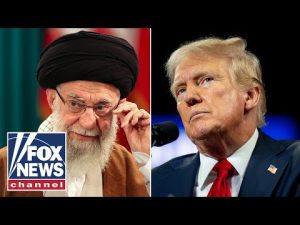In a surprising turn of events, the latest tweet from the President was more than just a 280-character diplomatic missive. The Commander-in-Chief decided it was time to turn up the heat on Russian President Vladimir Putin, a move that has not gone unnoticed by analysts and diplomats alike. It appears he’s taken off the kid gloves and is ready to implement some seriously stringent sanctions. One can almost hear the Kremlin’s ears perk up at the mere mention of “secondary sanctions,” a strategy that could strike at the very heart of Russia’s war economy by targeting its dealings with nations like China and India.
The meeting of President Trump with Ukrainian President Volodymyr Zelenskyy at the Vatican further amplifies the administration’s efforts to bring the conflict to a close. Held in the solemnity of St. Peter’s Basilica, it was a powerful image of diplomacy. There were no cameras to record every nod and whisper, just the two leaders hashing out issues in the privacy such sensitive discussions demand. Observers note that this intimate tête-à-tête is a far cry from other, less successful, encounters and speculate that it might just pave the way for genuine progress.
As the stage is set for heightened sanctions, voices in Congress are echoing across the aisle, calling for more decisive action against Russia. The usually reserved ranks of congressional Republicans are surprisingly vocal, perhaps buoyed by constituents who have had their fill of Russia’s aggressive posture. Figures like Senator Chuck Grassley are urging the President to tighten the screws on Putin. It seems the days of subdued politicking may be over as more Republicans advocate for standing firm against the Russian aggressions, signaling a potential shift in the party’s foreign policy stance.
Meanwhile, discussions around Iran’s nuclear ambitions continue to resemble an endless chess match, with U.S. officials trying to pin down an evasive opponent. Though talks in capitals such as Oman and potential upcoming rounds in Europe keep hopes of an agreement alive, many question whether these discussions will lead to a substantial outcome or just more diplomatic circling. The administration remains keen on ensuring Iran dismantles its nuclear program, but as any seasoned diplomat will tell you, getting Iran to that negotiating table is akin to wrangling cats.
The geopolitical game continues, and while some may scoff at these diplomatic dances as a soirée of inefficiencies, the reality is that the stakes are higher than ever. These discussions and decisions will shape the future of not just international relations but potentially global peace itself. As President Trump pushes forward with his hardline approach, both allies and adversaries wait with bated breath to see if the strategy will hold or if it will become another chapter in a long saga of diplomatic brinkmanship. In the meantime, for those of us watching these political machinations unfold, let’s just hope it doesn’t turn into a bad episode of déjà vu.







